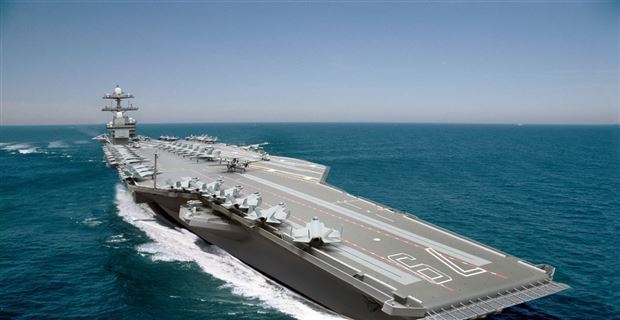Special Analysis: The Navy's 2nd Ford-Class Carrier -USS Kennedy
The 2nd US Navy Ford-Class high-tech aircraft carrier has grown 70-feet longer and is now 50-percent structurally complete with the addition of the lower stern,
The 2nd US Navy Ford-Class high-tech aircraft carrier has grown 70-feet longer and is now 50-percent structurally complete with the addition of the lower stern, Huntington Ingalls Industries announced.
“We are halfway through lifting the units onto the ship, and many of the units are larger and nearly all are more complete than the CVN 78 (USS Ford) lifts were. This is one of many lessons learned from the construction of the lead ship that are helping to reduce construction costs and improve efficiencies on Kennedy,” Mike Shawcross, Newport News’ vice president, John F. Kennedy (CVN 79) and Enterprise (CVN 80) aircraft carrier construction, said in a written statement.
HII ship developers have been employing a newer construction strategy for the Kennedy, involving a handful of techniques intended to lower costs and call upon lessons learned from the building of the first Ford-class carrier in recent years, the USS Gerald R. Ford (CVN 78).
With so much of the ship built, hundreds of structural units have been completed on items such as pipe assemblies, cabling, shafts, rudders and struts for the ship.
Huntington Ingalls Industries Video of USS Kennedy construction
The USS Kennedy will replace the USS Nimitz which is due to retire by 2027; the Ford-class carriers are slated to replace the existing Nimitz-class carriers on a one-to-one basis in an incremental fashion over the next fifty years or so.
One of the construction techniques for Kennedy construction has included efforts to assemble compartments and parts of the ship together before moving them to the dock – this expedites construction by allowing builders to integrate larger parts of the ship more quickly.
This technique, referred to by Huntington Ingalls developers as “modular construction,” was also used when building the Ford; the process welds smaller sections of the ship together into larger structural “superlift” units before being lifted into the dry dock, HII statements explained.
Construction begins with the bottom of the ship and works up with inner-bottoms and side shells before moving to box units, he explained. The bottom third of the ship gets built first. Also, some of the design methods now used for the Kennedy include efforts to fabricate or forge some parts of the ship - instead of casting them because it makes the process less expensive, builders explained.
HII ship developers have been making an aggressive effort to lower costs of the USS Kennedy. Officials have said that the cost of the USS Kennedy will be well over $1.5 billion less than the costs to build the first Ford-Class ship.
The Navy received substantial criticism in recent years from lawmakers and government watchdog groups during the construction of the USS Ford for rising costs. Construction costs for the USS Ford wound up being several billion above early cost estimates. Cost overruns with the construction wound up leading Congress to impose a $12.9 billion cost-cap on the ship.
At the time, Navy officials pointed out that integrating new technologies brings challenges and that at least $3 billion of the Ford’s costs were due to what’s described as non-recurring engineering costs for a first-in-class ship such as this. Nonetheless, service leaders have consistently said that the Navy is making substantial progress with efforts to lower costs for the Kennedy.
Also, Newport News Shipbuilding – a division of HII - was able to buy larger quantities of parts earlier in the construction process with the Kennedy because, unlike the circumstance during the building of the USS Ford, the Kennedy’s ship design was complete before construction begins.
As for the design, the Kennedy will be largely similar to the design of the USS Ford, with a few minor alterations. The Kennedy will receive a new radar and its aircraft elevators will use electric motors instead of a hydraulic system to lower costs.



